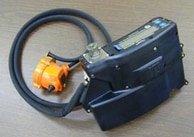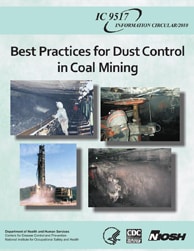Mining Feature: Trend in Black Lung Cases Concerns NIOSH Researchers
Friday, December 9, 2011

NIOSH OMSHR Personal Dust Monitor
Implementation of dust control technology and improved dust monitoring are effective ways for mine operators to reduce worker exposure to respirable coal dust. NIOSH’s Office of Mine Safety and Health Research is working in several areas to assist the coal industry’s efforts to limit miner exposure to dust.
Inhalation of respirable-sized coal dust can lead to the development of coal workers’ pneumoconiosis (CWP, commonly called black lung), a disabling and potentially fatal lung disease. NIOSH research has recently started seeing some unfortunate trends regarding CWP.
NIOSH staff at the Division of Respiratory Disease Studies in Morgantown, WV conducts the Coal Workers' Health Surveillance Program as mandated by the Federal Coal Mine Health and Safety Act of 1969. In this program, underground coal miners can volunteer to be periodically examined for the presence of CWP at no cost to the miner. Since 2000, results from this program show an increase in the prevalence of CWP, following a steady decline over the previous 30 years. In addition, severe cases of CWP are being identified in miners at younger ages.
NIOSH's Office of Mine Safety and Health Research (OMSHR) staff conducts research to identify improved dust control and monitoring technologies that can be used by the mining industry to reduce mine worker exposures to harmful respirable dust. Research has been conducted to address occupations at high-risk for overexposure, resulting in the development of dust controls for longwall, continuous miner, and roof bolting operations. Details of the research currently being conducted by OMSHR are provided at the NIOSH mining website Research Program page.
A recent NIOSH publication, "Best Practices for Dust Control in Coal Mining," summarizes state-of-the-art dust control technologies. This information can be used by coal mine operators to select proven control technologies that have application in their respective mines. To further promote the transfer of this information to the coal industry, OMSHR researchers have conducted a series of dust control workshops in the major coal mining regions of the country. Videos of these presentations are available for download at the NIOSH mining website.
Another key component in reducing exposures to coal dust is the development of improved dust monitoring instrumentation. Current dust sampling procedures do not provide mine workers and operators information on dust exposures until days or weeks after the sample is collected. OMSHR has conducted research to develop the Personal Dust Monitor (PDM) that provides dust exposure information to the miner on a real-time basis. With this knowledge, dust control technologies and/or operating practices can be modified with the goal of preventing an overexposure from occurring.
In order for the Personal Dust Monitor to be used as a certified dust sampler in underground coal mines, the sampler must meet specific performance criteria.. For this certification, the Mine Safety and Health Administration (MSHA) first evaluates the instrument for safety concerns and then NIOSH evaluates the sampling performance. On September 6, 2011, NIOSH certified the PDM as meeting the criteria making it available for use as a compliance dust sampler.
MSHA is responsible for establishing and enforcing dust regulations in the mining industry. In light of the increase in CWP and the new instrumentation developed by NIOSH, MSHA has proposed a new dust sampling regulation (Lowering Miners' Exposure to Respirable Coal Mine Dust, Including Continuous Personal Dust Monitors). This rule proposes to reduce the respirable coal dust standard from 2 mg/m3 to 1 mg/m3 and utilize the now certified PDM as the focal point of their new dust sampling program. The public comment period for this proposed rule has closed and MSHA plans to enact this new rule by April 2012.
MSHA related content
NIOSH OMSHR related links
- Performance of a New Personal Respirable Dust Monitor for Mine Use
- Laboratory and Field Performance of a Continuously Measuring Personal Respirable Dust Monitor
- Equivalency of a Personal Dust Monitor to the Current United States Coal Mine Respirable Dust Sampler
- Best Practices for Dust Control in Coal Mining
- Control of Respirable Dust
- Enhanced Utilization of Personal Dust Monitor Feedback
- Equivalency of a Personal Dust Monitor to the Current United States Coal Mine Respirable Dust Sampler
- Evaluation of the Approach to Respirable Quartz Exposure Control in U.S. Coal Mines
- Miners' Views about Personal Dust Monitors
- Miners' Views About Personal Dust Monitors
- An Overview of Fundamental and Emerging Technologies to Monitor and Control Respirable Dust in Underground Coal Mines in the United States
- Performance of a New Personal Respirable Dust Monitor for Mine Use
- Respirable Dust Control for Surface Mines
- Suggestion of a Cause-and-Effect Relationship Among Coal Rank, Airborne Dust, and Incidence of Workers' Pneumoconiosis
